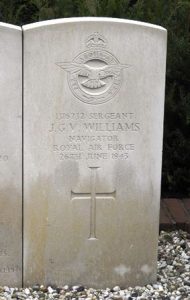The old mining town of Pontyberem lies on the Gwendraeth Fawr between Kidwelly and Cross Hands. Men of the town who gave their lives during both World Wars are remembered on the War Memorials inside the Memorial Hall at Coalbrook Road. These men are remembered below. Many thanks to Keith Evans for sending me the names from the World War Two Memorial.
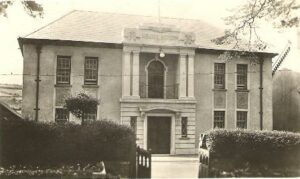
The Great War, 1914-1918
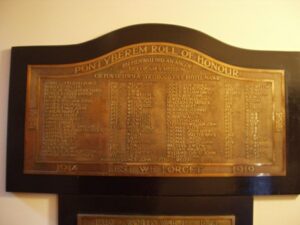
William George Aubrey, Private, 1301, Welsh Guards. William was born at Burry Port on 16 December 1893, the son of John Aubrey and Mary Aubrey (nee Watkins). He was the brother of the Reverend John Aubrey, of Rhoslwyn Villa, Penybank, Ammanford. The family later resided at New Lodge, Pontyberem. William worked as a Fireman at the New Dynant Colliery, but when war was declared, he enlisted at Kingston, Surrey into the Welsh Regiment. Later he transferred into the 1st Battalion, Welsh Guards, which were attached to 3 Brigade, Guards Division. William served with the Welsh Guards at the Battle of Loos, and fought with them on the Somme in 1916. He suffered terrible injuries from a German shell explosion at Sailly-Saillisel on 10 December 1916 and died the same day. William was 23 years old, and is buried at Bronfay Farm Military Cemetery, Bray Sur Somme, France.
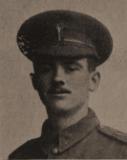
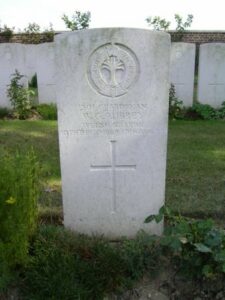
Walter Bentley, Driver, 117665, Royal Field Artillery. Walter was the son of George and Mary Jane Bentley, of 5, Gwendraeth Row, Pontyberem, and enlisted at nearby Llanelli into the Royal Field Artillery, being posted to the 30th Division Ammunition Column. In November 1915 the Division moved to France, and saw its first major action during the Somme Offensive, at the Battle of Albert, capturing Montauban. They then fought at the Battle of Le Transloy and followed up the German withdrawal to the Hindenburg Line in March 1917, before taking part in the Arras Offensive. They then moved to Ypres, and fought at the opening of Third Ypres, at the Battle of Pilckem, where Walter was killed in action on 13 July 1917, aged 23. He is buried at Reninghelst New Military Cemetery, Belgium.
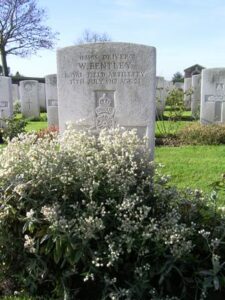
William Richard Beynon, Private, 12972, South Wales Borderers. William was born in Llandyfaelog on 15 May 1888, the son of Walter Beynon and Jane Beynon (nee Jenkins). William worked as a collier prior to the war and after marrying Mary Jane George at Pontyberem on 14 May 1911, the couple set up home together at Pantyfer. William then found work as a haulier for the Co-Operative Stores at Pontyberem. He enlisted at Tumble soon after the outbreak of war and was posted to the 4th Battalion, South Wales Borderers, which was attached to the 40th Brigade, 13th (Western) Division. On 13 June 1915 the Division sailed for the Mediterranean, and during July 1915 landed on Cape Helles, relieving the 29th Division, before moving to ANZAC Cove from 3 August 1915, taking part in the Battles of Sari Bair, Russell’s Top, and Hill 60, ANZAC. Soon afterwards the Division was transferred from ANZAC to Suvla Bay, and it was evacuated from Suvla on 19 December 1915, transferring to Helles. On 8 January 1916, the Division was evacuated from Helles, and by 31 January was concentrated at Port Said, where they held forward posts in the Suez Canal defences. On 12 February 1916 the Division began to move to Mesopotamia, to strengthen the force being assembled for the relief of the besieged garrison at Kut al Amara, but the relief failed, and Kut fell to the Turks. The Division then took part in the advance through Mesopotamia, which was to successfully liberate the country from centuries of Ottoman rule. By January 1917 the 13th Division had taken up positions facing the Hai Salient, and began to press attacks. On 15 February Welshmen of 40 Brigade, 8th RWF and 4th SWB, broke the centre of the enemy position and were followed up by troops of the 13th and 14th Divisions who completed the rout. Two days later General Cobbe launched an attack on the Sannaiyat positions, but the Turks held out until nightfall on 23 February following a surprise river crossing by the Norfolk’s and Ghurkhas which forced the Turks to withdraw again. By 25 February the Turks were in full retreat, pursued by the 13th and 14th Divisions and the Cavalry and halted at Azizaya, midway between Kut and Baghdad, while the British supply lines were adjusted. William was killed in action here on 25 February 1917. The 29-year-old has no known grave, so is commemorated on the Basra Memorial, in Iraq. William is also commemorated on the Llandyfaelog War Memorial, alongside his half-brother, George Beynon, who was killed in France on 13 April 1918.
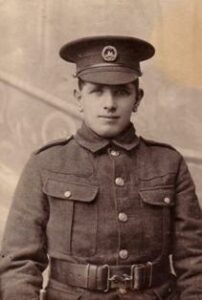
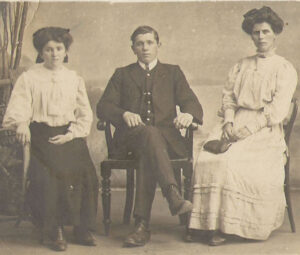
Eliezor Bishop Bowen, Private, 201423, Welsh Regiment. Eliezor was born in 1884, the son of David and Mary Bowen, of 5, Club House, Felinfoel. He worked as a Collier prior to the war, then served during the war with the 4th Battalion, Welsh Regiment. Eliezor survived the war, returning to live with his brother-in law and sister, John and Catherine Jenkins, at Bryngwili, Pontyberem. Eliezor had suffered because of his wartime service, dying of Chronic Otorrhoea on 7 May 1920, aged 35. Eliezor is not eligible for commemoration by the CWGC, as his death cannot be proved to be linked to his war service.
Evan John Davies, Private, 4162, Welsh Regiment. Evan was the son of David and Emma Davies, of 12, Caroline Street, Llanelli. He resided at Pontyberem prior to the war, and served with the 1/4th Battalion, Welsh Regiment, which was the local Territorial Battalion, attached to 159 Brigade, 53rd (Welsh) Division. The Division landed at Cape Helles, Gallipoli, on 9 August 1915, and was immediately thrown into action, spending the next few days in isolated pockets, fighting against a Turkish counter-attack during the Battle of Sari Bair, and then at the Attack on Scimitar Hill. Evan was killed here on 16 August 1915, aged 19. He is commemorated on the Helles Memorial, Gallipoli.
Thomas Davies, Private, 2042, Welsh Guards. Thomas was the son of Benjamin and Mary Davies, of Robusson Cross, Milford. He resided at Pontyberem prior to the war, and enlisted at Carmarthen into the 1st Battalion, Welsh Guards. The battalion formed on 26 February 1915, and moved to France, where it joined 3rd Guards Brigade, Guards Division. They saw their first major action during the Battle of Loos on 25 September 1915, remaining in the area during the coming months, where they also fought in the subsequent Action of Hohenzollern Redoubt. In July 1916 the Division moved to the Somme, where they fought at the Battle of Flers-Courcelette. Thomas was wounded here, and died on 19 September 1916. He was 39 years old, and is buried at Grove Town Cemetery, Méaulte, France.
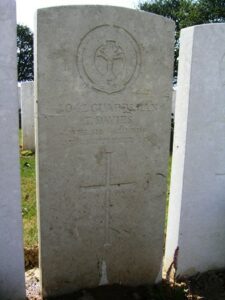
William John Davies, Lance Corporal, 235210, Royal Welsh Fusiliers. William was the son of William and Mary Davies, of 8, Mynachlog Terrace, Pontyberem. He enlisted at Pontyberem into the Welsh Regiment on 18 November 1914 and spent two years with the 4th Welsh Reserves as a Drill Instructor. On 22 March 1918 William embarked for France, and joined the 9th Battalion, Royal Welsh Fusiliers, which were attached to 58 Brigade, 19th (Western) Division. The Division was caught up in heavy fighting following the German offensive which had been launched on 21 March, and took heavy casualties during the resulting Battle of St. Quentin and the Battle of Bapaume, before being relieved and moved to positions near Messines to rebuild and rest. Unluckily for them though, the Germans switched the focus of their attack to Flanders on 9 April 1918 and over the coming weeks the division took part in a desperate rearguard action. William was killed in action at the Battle of Messines on 29 April 1918. He was 32 years old, and is remembered on the Tyne Cot Memorial, Belgium.
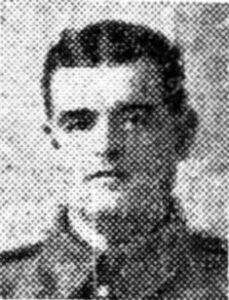
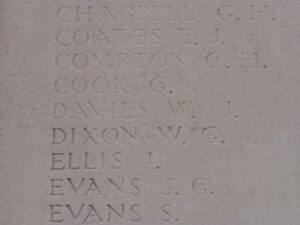
Henry Arthur Dobson, Private, 203210, North Staffordshire Regiment. Henry was the son of David and Hannah Jane Dobson, of 26, Hodgkinson Street, Chesterton, Staffordshire. He was a miner prior to the war, and must have worked at Pontyberem prior to enlisting at Newcastle, Staffs into the North Staffordshire Regiment on 11 December 1915. On 14 March 1918 Henry landed in France, and was posted to the 1st Battalion, North Staffordshire Regiment, which was attached to 17 Brigade, 6th Division. The division had seen heavy fighting throughout 1917, during the Battle of Vimy Ridge, and then the Battle of Messines, and then at Third Ypres, at the Battles of Pilckem and Langemarck. The Division then moved south, to hold a section of the front north of St. Quentin, which is where Henry joined his battalion. The division was hit by the German Spring Offensive of 21 March 1918 at the Battle of St. Quentin. Henry was killed in action during the terrible period of desperate fighting that followed, on 29 March 1918, aged 26. He is buried at Premont British Cemetery, France.
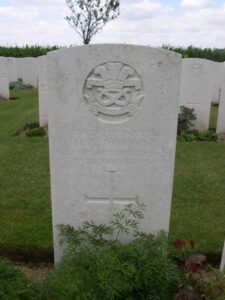
Henry Duggan, Private, 201688, Welsh Regiment. Henry was the son of John and Ellen Duggan, of Blaen-y-Wawr, Pontyberem. He enlisted at Carmarthen into the 1/4th Battalion, Welsh Regiment, which was formed during August 1914 in Carmarthen. The Battalion were then attached to 159 Brigade, 53rd (Welsh) Division, and in July 1915 sailed from Devonport for Egypt. On 9 August 1915 the Division had moved from Egypt, and landed on Gallipoli. They fought on Gallipoli until evacuation in December 1915, after suffering terrible casualties, and moved to positions on the Suez Canal. In early 1917 the British launched an attack into Palestine, which was occupied by the Turks, and Henry was killed in action here at the First Battle of Gaza, on 26 March 1917. He was 22 years old, and is remembered on the Jerusalem Memorial, Israel.
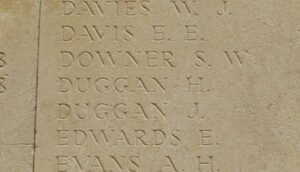
Stanley Edwards, Private, 200893, Welsh Regiment. Stanley was the son of Edward and Elizabeth Edwards, of 19, Railway Terrace, Pontyberem. He served during the war with the 1/4th Battalion, Welsh Regiment, which was attached to 159 Brigade, 53rd (Welsh) Division. Stanley served at Gallipoli with the battalion, and was evacuated from Gallipoli with the battalion to Egypt in January 1916. He returned home to Pontyberem on leave during the summer of 1916, and met up with his three brothers, who were all by then based in Pembrokeshire with the 2/4th Welsh. Stanley was discharged from the army as medically unfit on 3 April 1917. He died on 10 May 1923, aged 27, and is buried at Yr Hen Eglwys cemetery, Pontyberem. Stanley is not eligible for commemoration by the CWGC, as his death cannot be proved to be linked to his war service and he died after the CWGC cut off date. The photograph of Stanley and his headstone have been kindly sent in by his Great Nephew Gary Jenkins of Cardigan, but it is a mystery why Stanley is wearing the uniform of the Royal Artillery?
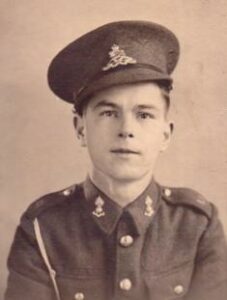
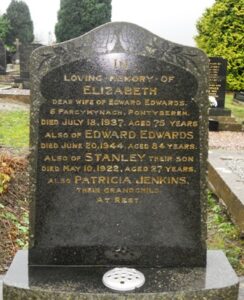
Daniel Evans, Private, 11668, Welsh Regiment. Daniel was the Husband of Margaret Evans, of Tanygraig Cottage, Pontyberem, Carmarthen. He enlisted at Carmarthen on 18 August 1914 into the 8th Battalion, Welsh Regiment, and saw action in Gallipoli, before being wounded on 8 August 1915, when he was shot in the foot, and returned to Britain. Daniel was at Kinmel Park until 10 August 1916, when he was posted to the 2nd Welsh in France. He was transferred to the 9th Welsh until 19 December 1916, when he became attached to the Base Depot at Etaples. Daniel was posted to the 14th Welsh on 8 August 1918, which was preparing for its assault across the River Ancre on 21 August. Daniel was wounded again on 7 September 1918, within weeks of the offensive starting, and was discharged from the army as unfit on 29 January 1919. He suffered badly from his wounds after the war, and died as a result on 12 April 1921, aged 33. Daniel’s case has recently been forwarded to the CWGC, as he is presently not commemorated by them. The location of Daniel’s grave has not yet been identified.
David Onslow Greville, 2nd Lieutenant, West Yorkshire Regiment. David was the son of David and Catherine Thomas, of Glangwendraeth, Pontyates. His father died when he was young, and his mother remarried Thomas Greville, of Maes Derwen, Pontyberem, who adopted David. David was commissioned into the West Yorkshire Regiment, and posted to their 16th Battalion, which were attached to 93 Brigade, 31st Division. The Division had originally been moved to Egypt in December 1915 and then in March 1916 moved to the Western Front, where they took part in the opening of the Somme Offensive, during the Attack on Serre. They suffered terrible casualties here, and were withdrawn from the line for several months to rest and rebuild, before being moved into positions at Arras, where they took part in the Battle of the Scarpe, where David was killed in action on 3 May 1917. He was 24 years old, and is remembered on the Arras Memorial, France.
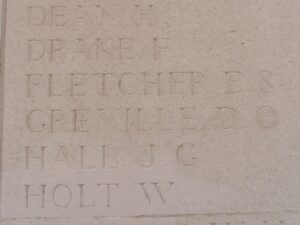
Evan Frederick Griffiths, Private, 356401, King’s Liverpool Regiment. Evan was the son of Rhys Gwilym Griffiths, M.E., and Leah Griffiths, of Arfryn, Pontyberem. Evan had been educated at the University of Wales, Aberystwyth, and had graduated with a B.A. He enlisted at Southport, Cheshire into the 13th Battalion, King’s Liverpool Regiment, which had crossed to France in September 1915 attached to 76 Brigade, 25th Division. Here the Brigade was attached to the 3rd Division, before the Battalion transferred to 8 Brigade, 3rd Division, at Ypres. They took part in actions at Bellewaarde and St. Eloi before moving to 9 Brigade, still with the 3rd Division, and moving to the Somme. Evan was killed in action during the Battle of the Somme, on 16 August 1916. He was 27 years old, and is remembered on the Thiepval Memorial, France.
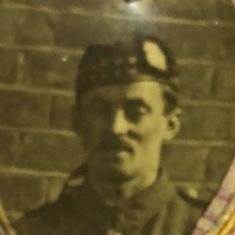
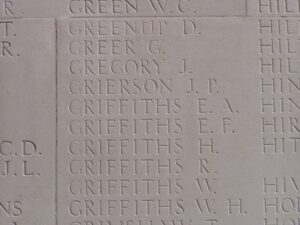
Rhys Griffiths, Private, 63926, Royal Army Medical Corps. Rhys was the son of David and Anne Griffiths, of Meilog, Pontyberem. He was undergoing training for the ministry prior to the war, but his sense of duty drove him to enlist at Carmarthen into the Royal Army Medical Corps. After undergoing training, he was posted to the 106th Field Ambulance, which was attached to the 35th Division. The Division moved to France early in 1916, and took up positions in French Flanders, in the Neuve-Chapelle sector. Rhys was killed in action by a shell while attempting to reach a wounded officer in order to give him first-aid on 30 May 1916. He was 23 years old, and is buried at St. Vaast Post Military Cemetery, Richebourg-L’Avoue, France.
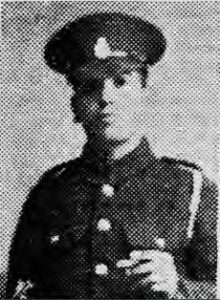
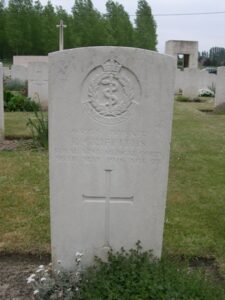
Willie Griffiths, Private, 53625, Welsh Regiment. Willie was the son of David and Louisa Griffiths, of 24, Furnace Terrace, Pontyberem. He enlisted at Llanelli into the army, and was posted to the 15th Battalion, Welsh Regiment, the Carmarthen Pals battalion, which had been in France since December 1915 attached to 114 Brigade, 38th (Welsh) Division. The Division had taken part in the famous capture of Mametz Wood during July 1916, and the capture of Pilckem Ridge on 31 July 1917. Over the winter of 1917-1918 the Division was at Armentieres, and on 6 March 1918 the 15th Welsh relieved the 13th Welsh in support trenches at Houplines. Eight men were wounded by gas on 9 March, and for the next few days the area was continually shelled and gassed by the Germans. Willie was wounded here, and brought to a Casualty Clearing Station at Merville, where he died of wounds on 11 March 1918. He was just 22 years old, and is buried at Merville Communal Cemetery Extension, France. The photograph shows Willie on the right along with his friend William Hughes, who also fell, on the left.
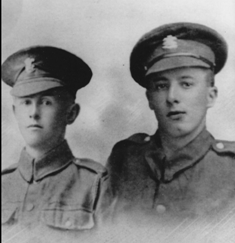
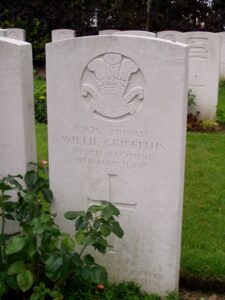
David Harris, Private, 2559, Welsh Guards. David was born at Briton Ferry, but resided at Pontyberem prior to the war. He enlisted at Caterham into the Welsh Guards, and went to France early in 1916, probably joining the 1st Battalion, Welsh Guards at Calais, where they were resting after their part in the Battle of Loos. The Welsh Guards moved to Ypres in July 1916, but by September 1916 moved again, taking up positions on the Somme. On 9 September 1916 the Welsh Guards marched to Carnoy, to take part in an attack on Flers-Courcelette. David was killed in action the following day, on 10 September 1916. He is buried at Delville Wood Cemetery, Longueval, France.
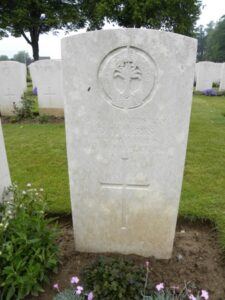
John Hough, Gunner, 117671, Royal Field Artillery. John was born at Aspull, Lancashire, the son of Walter Victor and Bertha Ellen Hough. The family had moved to Supply Stores, Pontyberem prior to 1911. John enlisted at Llanelli into the Royal Field Artillery, and prior to moving to France married Catherine M Davies at Pontyberem. John was posted to their ‘C’ Battery, 285th Brigade. The Brigade had been formed in February 1915 and joined the 57th Division, which moved to France in February, 1917. It served with the Division until the end of the war, and saw action at Third Ypres, and during the finals advance to victory in 1918. John was killed in action during the Battle of the Canal du Nord, on 30 September 1918. He was just 21 years old, and is buried at Naves Communal Cemetery Extension, France.
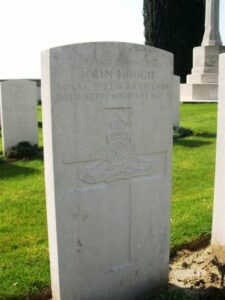
William Hughes, Private, 54595, Welsh Regiment. William was the son of Jeremiah and Mary Ann Hughes, of Ael-Y-Bryn, Pontyberem. He enlisted at Carmarthen into the army, and was posted to France around August 1916 to join the 15th Battalion, Welsh Regiment, the Carmarthen Pals battalion. The battalion had been in France since December 1915 attached to 114 Brigade, 38th (Welsh) Division, and had just taken part in the capture of Mametz Wood. William joined them at Boesinghe, where they held the Canal Bank positions over the coming months. William was killed during a trench raid on the Mortjelde Salient on 30 April 1917, aged 20. He was originally buried in a battlefield cemetery at Manneken Farm, and during September 1924 his body was reinterred at Perth Cemetery (China Wall), Belgium. The photograph shows William on the left along with his friend Willie Griffiths, who also fell, on the right.

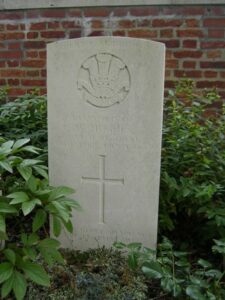
William James, DCM, MM, Corporal, 1728, East Surrey Regiment. William was the son of James and Ann James, of Bryncrwn, Mynyddcerrig, Pontyberem. He enlisted at Tumble into the East Surrey Regiment on 6 September 1914, but was discharged as medically unfit. Undeterred he re-enlisted at Shoreham into the 8th Battalion, East Surrey Regiment, which was attached to 55 Brigade, 18th (Eastern) Division. The Division moved to France in May 1915, and saw its first major action in the Battle of Albert in July 1916. The Division fought throughout the Somme offensive, and in March 1917 followed the German Retreat to the Hindenburg Line. In 1917 the Division took part in the Third Battle of the Scarpe, which was part of the Arras Offensive, then moved to Ypres, where it took part in the Battles of Pilckem, Langemarck, and at the First and Second Battles of Passchendaele. In 1918 the Division were stationed south of the Somme, and were one of the Divisions hit there by the German Spring Offensive, which was launched on 21 March 1918, and fought a heroic rearguard action towards Villers-Brettoneux. William was killed on the Somme on 4 April 1918, aged 25. He is commemorated on the Pozieres Memorial, France. William was a brave man. He was awarded the Distinguished Conduct Medal and the Military Medal during his time at war.
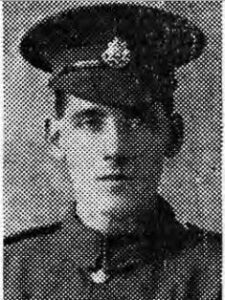
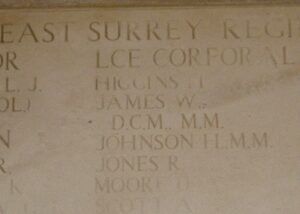
Richard Miles Jenkins, Private, 94253, Royal Welsh Fusiliers. Richard was the son of James and Jane Jenkins, of Llannon. He resided in Bryngwili, Pontyberem prior to the war and enlisted into the Monmouth Regiment at Llanelli. He subsequently transferred to the 17th Battalion, Royal Welsh Fusiliers, which was attached to 113 Brigade, 38th (Welsh) Division, which had been in France since December 1915. They fought through some of the hardest and most famous battles of the Great War, capturing Mametz Wood during the Battle of the Somme, and the Pilckem Ridge during the battle of Passchendaele. Over the winter of 1917-1918, the 38th Division was stationed around Armentieres, and in April 1918 were rushed to positions around Aveluy Wood, north of Albert, to bolster the beleaguered defences there, which had been pushed back by the German spring offensive of March 1918. The Welshmen held this sector over the coming months, and on 21 August 1918 launched an assault over the flooded River Ancre, within days capturing Thiepval and Pozieres Ridge. The Division fought at the Battle of Bapaume, and then beyond to the Hindenburg Line at the Battles of Havrincourt, Epehy and Beaurevoir. They then pushed towards Le Cateau, which had been in German hands since 1914, and onwards towards the Selle and the Sambre. Richard was killed in action during the Battle of the Sambre, on 4 November 1918, just a week before the Armistice. He was 28 years old and is buried at Englefontaine British Cemetery, France.
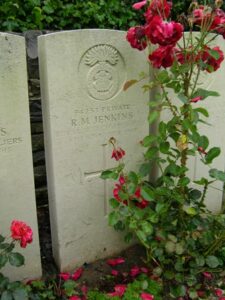
Ben John Jones, Private, 69527, Royal Army Medical Corps. Ben was born at St. Ishmaels, Carmarthenshire. He resided at Als Park, Pontyberem, and was a Medical Student prior to enlisting into the Royal Army Medical Corps. Ben served in Italy, before becoming ill with tuberculosis, and was admitted to Bermondsey Military Hospital on 5 September 1918. He was then transferred to Hospital at Cardiff, but returned home, where he died on 9 March 1920, aged 25. Ben has recently been accepted by the CWGC for commemoration (January 2012) following evidence presented by myself, and his name will be added to the Brookwood (1914-1918) Memorial, as his place of burial has not yet been identified.
Ivor Sidney Jones, Private, 40263, Welsh Regiment. Ivor was the son of John and Margaret Jones, of Vale View, Pontyberem. He enlisted at Carmarthen into the army, and was posted to France in the summer of 1916, where he joined the 16th Battalion, Welsh Regiment. The battalion had been in France since December 1915 attached to 114 Brigade, 38th (Welsh) Division, and took up positions in the Nursery Sector near Armentieres. In June 1916 they moved south to the Somme, and fought in the Battle of Mametz Wood. The first attack went in on 7 July 1916, and Ivor was killed in action that day. He was just 21 years old, and is remembered on the Thiepval Memorial, France.
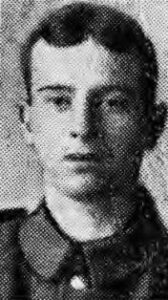
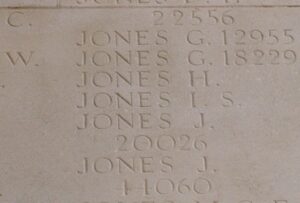
John Jones, Private, 44060, Welsh Regiment. John was the son of John and Sarah Jones, of Jubil Cottage, Pontyberem. He was another local boy who enlisted into the army, and was posted to the 15th Battalion, Welsh Regiment, the Carmarthen Pals battalion, which was attached to 114 Brigade, 38th (Welsh) Division. The brigade landed at Havre during December 1915, and took up positions in the Nursery Sector near Armentieres. In June 1916 they moved south to the Somme, and fought in the Battle of Mametz Wood. The first attack went in on 7 July 1916, and failed. The next large scale assault was on 10 July, and over the coming night the Welshmen were thrown into murderous hand to hand combat within the wood. John was killed here on 11 July 1916. He was just 20 years old, and is remembered on the Thiepval Memorial, France.
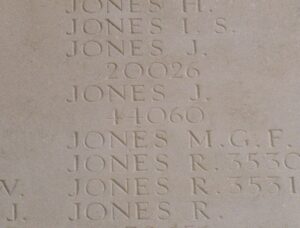
William David Jones, Wireless Operator, Mercantile Marine. William was the son of David and Mary Jones, of 6, Bryn Terrace, Pontyberem, and served as a Wireless Operator in the Mercantile Marine, aboard the SS Cheviot Range. Cheviot Range had been built in 1914, and had served throughout the war, but was attacked by a German Submarine off the Lizard on 21 February 1918, and was sunk by a torpedo. William was drowned as a result. He was only 20 years old, and is remembered on the Tower Hill Memorial, London.
William Thomas Jones, Gunner, 171488, Royal Garrison Artillery. William was the son of William John and Elizabeth Jones, of Paris House, Pontyberem, and enlisted at Llanelli into the Royal Garrison Artillery. William was posted to their 195th Siege Battery, and moved to the Western Front at some time during 1917. William was killed in action during the British offensive towards Cambrai on 24 September 1918. He was 20 years old, and is buried at Windmill British Cemetery, Monchy-Le-Preux, France.
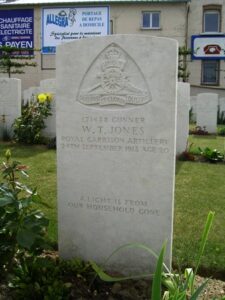
Thomas James Lewis, Private, 509, Welsh Regiment. Thomas was the son of Joseph and Ann Lewis, of Brynhawddgar, Mynyddcerrig, Pontyberem. He enlisted at Carmarthen into the 1/4th Battalion, Welsh Regiment, which was formed during August 1914 in Carmarthen. The Battalion was then attached to 159 Brigade, 53rd (Welsh) Division, and in July 1915 sailed from Devonport for Egypt. On 9 August 1915 the division had moved from Egypt, and landed on Gallipoli. The next few days were chaotic, with small scale battles raging around the Peninsula, and Thomas was killed in action on 12 August 1915. He was 23 years old, and is remembered on the Helles Memorial, Gallipoli.
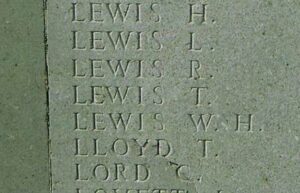
Patrick McLoughlin, Sapper, 66818, Royal Engineers. Patrick was born on 16 August 1876, the son of Christopher and Margaret McLoughlin, of Main Street, Longford, Ireland. By 1911 Patrick had moved to Cilrhedyn, Pontyberem, with his wife Hannah McLoughlin, and son Christopher. He enlisted into the Royal Engineers, and served with their 36th Airline Section. It is probable that the Airline Sections worked in conjunction with the Tunnelling Companies, and so Patrick was on the Somme in late 1916, where the Tunnelling Companies were driving mines under High Wood. Patrick was killed in action on the Somme on 10 September 1916, aged 40, and is buried at Bertrancourt Military Cemetery, France.
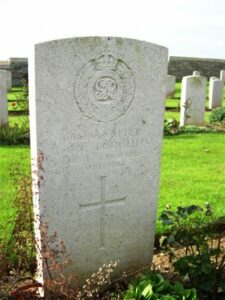
Albert Francis Merrick, Private, 18355, South Wales Borderers. Albert was born in Stroud, the son of Francis Charles and Ellen Merrick. He had served with the 3rd Battalion, Gloucester Regiment for a while after enlisting in 1901, and had moved to West Wales by 1911, residing at Pontyberem prior to the war. He travelled to Newport to re-enlist into the army and was posted to the 7th Battalion, South Wales Borderers. The Battalion was attached to 67 Brigade, 22nd Division, and landed at Boulogne on 6 September 1915. However, they were soon on the move again, and moved to Marseilles, where they sailed on 10 September 1915 for service in Salonika. The Division remained here for the duration of the war, and Albert was killed in action during the Battle of Doiran on 18 September 1918. He was 34 years old, and is buried in Doiran Military Cemetery, Salonika.
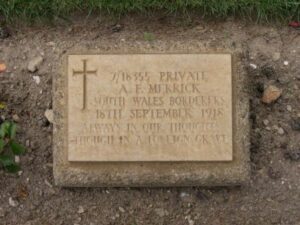
Albert Mills, Driver, W/4586, Royal Field Artillery. Albert was born at Milford Haven on 29 August 1876, the son of Joseph Mills and Anne Mills (nee Harries), of The Priory, Steynton. In 1902 he married Elizabeth Mary Phillips, and in the following years had six children. Albert had left his family at Milford when he moved to the Rhondda to work as a Carpenter and Joiner at the Tram Depot in Porth. In 1913 his wife and six children moved to join him at Porth, and by the outbreak of the Great War another child was on its way, and the family moved to Pontyberem. Albert volunteered in August 1914 and joined A Battery, 121st Brigade, Royal Field Artillery, which was attached to the 38th (Welsh) Division. In December 1915 the division moved to France, taking up positions in the line in Flanders, and moved to the Somme in June 1916, and took part in the successful capture of Mametz Wood. Here it was so badly decimated that the division was sent to positions north of Ypres, at Boesinghe, where it was to remain for the next 12 months, until taking part in the successful Battle of Pilckem on 31 July 1917. Following the fighting at Pilckem Ridge, the division was moved to a quieter sector on the Lys to rest. It was here, on 25 September 1917 that Albert was to drown whilst bathing in the River Lys. He was 41 years old, and was buried at Erquinghem-Lys Churchyard Extension, France.
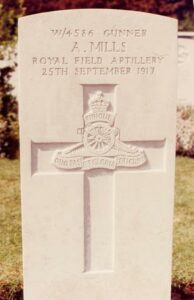
John Morgan, Private, 48946, Welsh Regiment. John was born in Llanddarog, the son of Thomas and Hannah Morgan. The family later moved to Tabor Villa, Cross Hands. John enlisted at Carmarthen into the 10th Battalion, Welsh Regiment, who were attached to 114 Brigade, 38th (Welsh) Division. The Division had landed in France during December 1915 and had spent their first winter in the trenches near Armentieres. In June they marched south to the Somme, where they were tasked with the capture of Mametz Wood. The attack on the wood began on 7 July, but met with fierce resistance, and it took until 14 July to clear the wood. The Division suffered terrible casualties at Mametz, and were taken out of the line, and moved to Ypres to rebuild. Here they fought at Pilckem and Langemarck, where John was killed in action on 19 August 1917, aged 26. He has no known grave, and so is remembered on the Tyne Cot Memorial, Belgium.
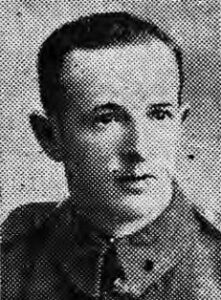
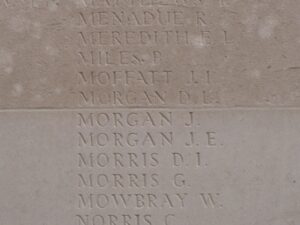
James O’ Brien, Private, 20794, York & Lancaster Regiment. James was the son of Patrick and Bridget O’Brien, of Kilcanavee, Kilmacthomas, Co. Waterford. He was a miner, and resided at Pontyberem prior to the war. James enlisted at Tumble into the Hussars, but was later posted to the 2nd Battalion, York and Lancaster Regiment, which was attached to 16 Brigade, 6th Division. On 10 September 1914 the Division landed at St Nazaire and proceeded to the Western Front, and arrived in time to reinforce the hard-pressed BEF on the Aisne, before the whole army was moved north into Flanders. Here they took part in the Action of Hooge during June, 1915, and in 1916 moved to the Somme, where the Division fought at the Battle of Flers-Courcelette, the Battle of Morval and the Battle of Le Transloy. James was killed here on 12 October 1916. He was 29 years old, and is commemorated on the Thiepval Memorial, France.
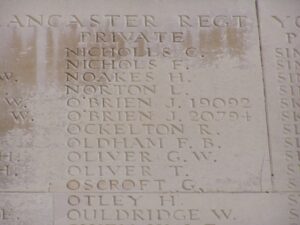
Joseph Picking, Corporal, 12912, South Wales Borderers. Joseph was the son of Joseph and Sarah Picking, of Haigh, Wigan. He was living at Bragdy, Pontyberem with his uncle, Albert France by 1911, working as a colliery labourer and married Annie Jane Thomas in 1914. Joseph enlisted in Tumble into the 1st Battalion, South Wales Borderers, which were attached to 3 Brigade, 1st Division, and moved to France as part of the BEF in August 1914. The Division fought at the Battle of Mons, and took part in the epic retreat to the Marne, where the German Advance was stopped in its tracks. They then followed the withdrawing Germans to the Aisne, and fought another pitched battle here, before being moved to positions east of Ypres. They famously halted the German attack towards Ypres, but at heavy cost, during First Ypres, and spent their first winter in Flanders. In 1915 the Division fought at the Battle of Aubers Ridge, and then at the Battle of Loos. They remained around Loos throughout the winter of 1915/1916 and moved to the Somme early in the Summer of 1916. Here they took part in the Battles of Albert and Bazentin and then at Pozieres, where Joseph was killed in action on 27 August 1916. He was 24 years old, and is remembered on the Thiepval Memorial, France. Annie married Rhys Parry in 1920, and the couple resided at 2, Wheel Row, Pontyberem, but Annie sadly died in 1936, aged just 40.
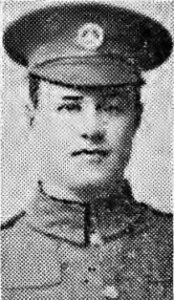
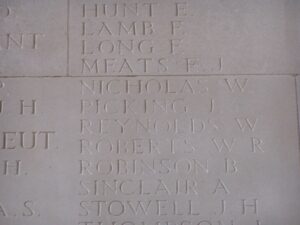
David Henry Rees, Gunner, 59755, Royal Garrison Artillery. David was the son of David and Mary Ann Rees, of 10, Dunraven Street, Caerau, Bridgend. He was living at Pontyberem prior to the war, and enlisted on 26 September 1914 into the East Lancashire Regiment, but was discharged on 9 January 1915 after having been deemed unfit for further service. Undeterred, David re-enlisted at Pentre into the Royal Garrison Artillery. David was posted to their 80th Siege Battery, and moved with them to the Western Front in 1916. David was died during the Battle of the Somme, on 10 September 1916. He was 29 years old, and is buried at Bouzincourt Communal Cemetery Extension, France.
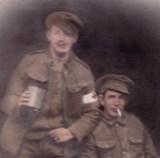
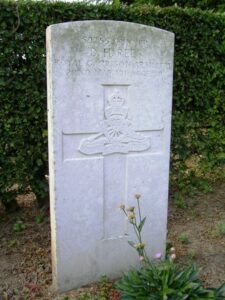
Alun Roberts, Private, 42561, South Wales Borderers. Alun was the son of David and Elizabeth Roberts, of Llainhir, Llanddarog. By 1911 the family had moved to 20, Railway Terrace, Pontyberem, and Alun worked as a Colliery Engine Driver. He enlisted at Llanelli into the Welsh Regiment, and was subsequently posted to France, joining the 10th Battalion, South Wales Borderers, which was attached to 115 Brigade, 38th (Welsh) Division. They fought through some of the hardest and most famous battles of the Great War, capturing Mametz Wood during the Battle of the Somme, and the Pilckem Ridge during the battle of Passchendaele. Over the winter of 1917-1918 the Division was stationed around Armentieres, and following the German offensive on the Somme, which was launched on 21 March 1918, were moved to positions at Aveluy Wood, north of Albert, where they bolstered the battered divisions there. The Germans had swept across the old Somme Battlefields, and had pushed the Allies back further than ever. However, the attack burnt itself out, and for several months this resulted in a stalemate settling along the line on the Somme. On 21 August 1918, the 38th Division launched an attack across the flooded River Ancre, and within days captured Thiepval Ridge and Pozieres, before taking part in the great advance towards the Hindenburg Line. They then pushed towards Le Cateau, which had been in German hands since 1914, and onwards towards the Selle, where Alun was killed in action on 18 October 1918, aged 25. He is buried in Cross-Roads Cemetery, Fontaine-Aux-Bois, France.
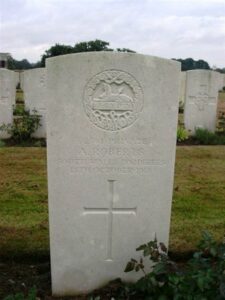
David Daniel Roberts, Private, 13420, Royal Welsh Fusiliers. David was the son of Charles and Mary Roberts, of Pontyberem. By 1911 he was residing at Allech Factory, Abercrave, Swansea and enlisted at Ferndale into the 2nd Battalion, Royal Welsh Fusiliers. This was the Battalion of the famous War Poets Siegfried Sassoon and Robert Graves, and had landed in France on 11 August 1914. The Battalion saw action during most of the Battles of the Great War, and were switched from Division to Division, as required. During 1917 they were attached to 19 Brigade, 33rd Division, and fought through the Somme Offensive. They fought at the Battle of Arras in spring 1917, then moved to Flanders, and fought at Third Ypres, during the Battle of the Menin Road, and at the Battle of Polygon Wood. David was killed in action at Polygon Wood on 26 September 1917, aged 30. He is remembered on the Tyne Cot Memorial, Belgium.
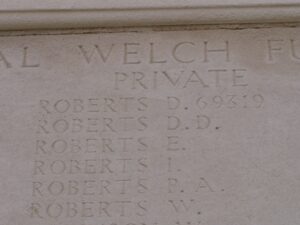
Michael Scully, Private, 8263, Welsh Regiment. Michael was the son of Hannah Scully, of 5, Garden Houses, Ebbw Vale. His connections with Pontyberem are as yet unknown, but he enlisted at Aberdare into the 2nd Battalion, Welsh Regiment. The Battalion was attached to 3 Brigade, 1st Division, and moved immediately to France at the outbreak of war, taking up positions around Mons in Belgium. Here they fought at the Battle of Mons, and in the epic retreat south to the Marne where the German advance was held. The Germans withdrew to the Aisne, where the BEF met them in Battle, and the 1st Division was then moved to defend Ypres. Michael was killed in action during the Battle of Gheluvelt on 31 October 1914, aged 27. He is remembered on the Ypres (Menin Gate) Memorial, Belgium.
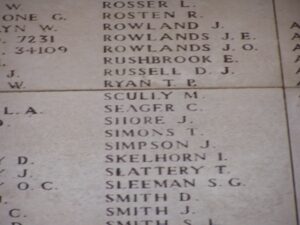
Thomas Smith, Private, 15665, Royal Welsh Fusiliers. Thomas was born in Burry Port, and resided in Pontyberem prior to the war. He enlisted at Mountain Ash into the 10th Battalion, Royal Welsh Fusiliers, which were attached to 76 Brigade, 25th Division. The Division landed at Boulogne on 27 September 1915, and the Brigade then transferred to the 3rd Division. The Division was in Flanders at the time, and the 10th RWF saw their first action here at Bellewaarde and St. Eloi in 1916. They then moved south to the Somme, to take part in the great offensive there, and fought through the Battles of Albert, Bazentin, and Delville Wood. Thomas was killed in action on the Somme on 16 August 1916, and is buried at Guillemont Road Cemetery, Guillemont, France. Thomas is not commemorated on the Pontyberem Memorial.
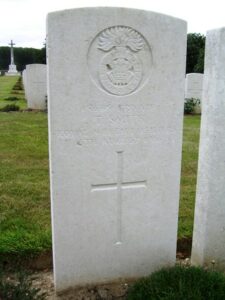
William John Stephens, Private, 13032, Royal Welsh Fusiliers. William was the son of Thomas and Catherine Stephens, of Wern Farm, Llanddarog. He enlisted at Tumble into the 9th Battalion, Royal Welsh Fusiliers, which moved to France in July 1915 attached to 58 Brigade, 19th (Western) Division. The Division moved to positions on the northern end of the Loos Sector, and on the opening of the Battle of Loos, made a brave but disastrous attack on the German lines, incurring heavy casualties. William was one of many men of the 19th Division killed on the opening day of the battle, 25 September 1915. He has no known grave, and is commemorated on the Loos Memorial, France.
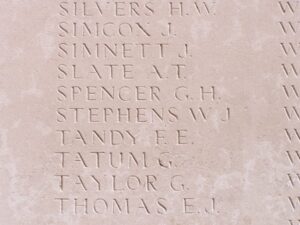
David Thomas, Private, 32295, East Lancashire Regiment. David was the son of John and Mary Thomas of Garn Ffrwd, Mynydd Cerrig, Pontyberem. He enlisted at Cardiff into the 2/1st Monmouthshire Regiment, which were attached to 205 Brigade, 68th Division. The Division remained in the UK on Home Service for the duration of war, but David transferred to the 1st Battalion, East Lancashire Regiment, which had been in France since 22 August 1914 attached to 11 Brigade, 4th Division. They had fought at Le Cateau, the Marne and the Aisne, and also at Messines in 1914 where they took part in the famous Christmas Truce. In 1915 they fought at Second Ypres, and in 1916 at Albert and Le Transloy during the Somme Offensive. Spring 1917 saw them at Arras, where they fought at the Battles of the Scarpe, and they then moved to Ypres, where they fought in the Battle of Polygon Wood, and at Broodseinde, where David was killed in Action on 4 October 1917 aged 30. He is remembered on the Tyne Cot Memorial, Belgium.
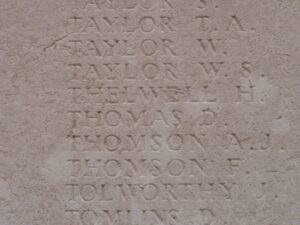
David John Thomas, Gunner, 161220, Royal Garrison Artillery. David was the son of John and Jane Thomas, of Bryn Cottage, Pontyberem. He was a stoker at Pontyberem Colliery prior to enlisting at Llanelli into the Royal Garrison Artillery. He trained at Fort Brockhurst, Gosport prior to being posted to 452 Siege Battery, RGA at Farnborough on 12 June 1917, then moved to the Western Front with their 2/1st Lancashire Heavy Battery, as part of the 57th Division. The Battery then transferred to the ANZAC Corps in France, and fought at Third Ypres with them in 1917. David was wounded during Third Ypres, and died of wounds on 23 August 1917, aged 24. He is buried at Dozinghem Military Cemetery, Belgium.
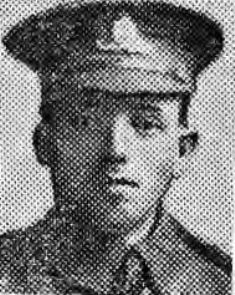
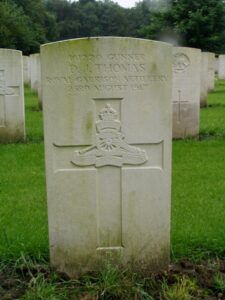
Ellis Thomas, Private, 12751, South Wales Borderers. Ellis was the son of Thomas and Catherine Thomas, of Bragdy, Pontyberem, and enlisted at Tumble into the 4th Battalion, South Wales Borderers. The Battalion were formed in August 1914 and became part of 40 Brigade, 13th (Western) Division. They embarked at Avonmouth on 29 June 1915, and landed at Gallipoli on 6 July 1915. They remained on Gallipoli for the duration of the campaign, until being evacuated on 8 January 1916. Ellis was wounded on Gallipoli, during the Battle of Sari Bair, between 6 and 10 August 1915, and died of wounds aboard a Hospital Ship on 15 August 1915, aged 35. He was buried at sea, and so is remembered on the Helles Memorial, Gallipoli.
George Thomas, Private, 497458, Labour Corps. George was the son of Eleanor Thomas, of Tyncwm Farm, Pontyberem. Very little is presently known about him, but he originally served with the 2/1st Battalion, Monmouth Regiment before transferring to the Labour Corps. George died on 28 November 1918, aged 36, and is buried at Pontyberem (St. John) Old Churchyard.
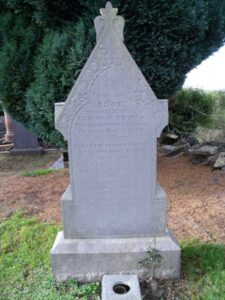
John Rees Thomas, Private, 33875, Royal Welsh Fusiliers. John was the son of David and Mary Ann Thomas, of Park House, Pontyberem. He enlisted at Tumble on 26 August 1914 into the 4th Battalion, South Wales Borderers, fighting at Gallipoli before being evacuated home wounded. When he recovered, John was posted to the 10th Battalion, Royal Welsh Fusiliers on 25 March 1916, which was attached to 76 Brigade, 25th Division. The Division landed at Boulogne on 27 September 1915, and the Brigade then transferred to the 3rd Division. The Division was in Flanders at the time, and the 10th RWF saw their first action here at Bellewaarde and St. Eloi in 1916. They then moved south to the Somme, to take part in the great offensive there, and fought through the Battles of Albert, Bazentin, and Delville Wood, and during the winter fighting on the Ancre. In April and May 1917 the Division fought through the Arras Offensive, and then moved to Ypres, where they took part in the Battles of Third Ypres. John was killed in action during Third Ypres, at the Battle of Polygon Wood, on 27 September 1917. He was 26 years old, and is remembered on the Tyne Cot Memorial, Belgium. His brother Walter also fell.
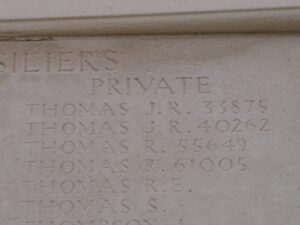
Walter Rees Thomas, Gunner, W/5517, Royal Field Artillery. Walter was the son of David and Mary Ann Thomas, of Park House, New Road, Pontyberem. He enlisted at Llanelli into the Royal Field Artillery, and served with their 111th Battery, 24th Brigade. The Brigade was attached to the 6th Division, and had been in France since reinforcing the BEF on the Aisne in September, 1914. They had fought at Hooge, and during the 1916 Somme Offensive, and then fought at Hill 70 and at the Battle of Cambrai in 1917. They were stationed near St. Quentin at the beginning of 1918, and were hit there during the German Spring Offensive of 21 March 1918. They were then moved to Flanders, and fought during the next desperate few months there, during the Battles of Bailleul and Kemmel, and during the Advance in Flanders, before moving south again, where they fought at the Battle of Épehy. Walter was killed in action here, during the advance on the Hindenburg Line, on 24 September 1918. He was just 21 years old, and is buried at Trefcon British Cemetery, Caulaincourt. His brother John also fell.
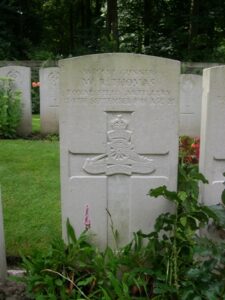
Gwilym Walters, Private, 201393, Welsh Regiment. Gwilym was the son of David and Mary Ann Walters, of Llanddarog. He enlisted at Pontyberem into the 1/4th Battalion, Welsh Regiment, which was formed during August 1914 in Carmarthen. The Battalion were then attached to 159 Brigade, 53rd (Welsh) Division, and in July 1915 sailed from Devonport for Egypt. On 9 August 1915 the Division had moved from Egypt, and landed on Gallipoli. They fought on Gallipoli until evacuation in December, 1915, after suffering terrible casualties, and moved to positions on the Suez Canal. In early 1917 the British launched an attack into Palestine, which was occupied by the Turks, and Gwilym was killed in action here, during the First Battle of Gaza, on 26 March 1917, aged 24. He is remembered on the Jerusalem Memorial, Israel.
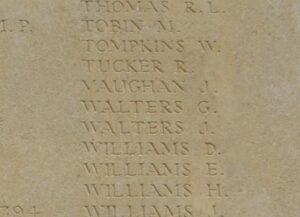
Maurice Whelan, Driver, 80425, Royal Field Artillery. Maurice was born at Waterford, and worked at Pontyberem as a miner prior to the war. He enlisted at Llanelli into the Royal Field Artillery, and was posted to France, where he joined A Battery, 63rd Brigade, Royal Field Artillery, which was attached to the 12th (Eastern) Division. The Division had been in France since 31 May 1915, and had fought on the Somme in 1916, and Arras and Ypres in 1917. It was stationed near Toutencourt on the Somme in the summer of 1918, alongside the 38th (Welsh) Division, and took part in an attack on Bouzincourt in July 1918. Maurice wasn’t at the front though. On 4 July 1918 he had been despatched with a horse and cart to remove some manure from horse lines near Contay when his horse bolted, overturning the cart. Maurice was trapped underneath, and died soon after from his injuries. He was 31 years old and is buried at Contay British Cemetery, France.
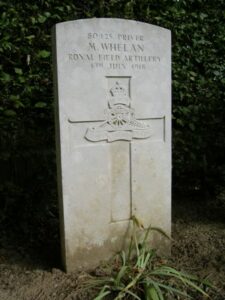
David John Williams, Private, 200277, Welsh Regiment. David was the son of John James Williams and Margaret Williams, of Preswylfa, Pontyberem. He enlisted at Carmarthen into the 4th Battalion, Welsh Regiment. David doesn’t look to have served overseas. He died at Pembroke on 27 January 1917, aged 19. David is buried in Pontyates (Nazareth) Congregational Chapelyard.
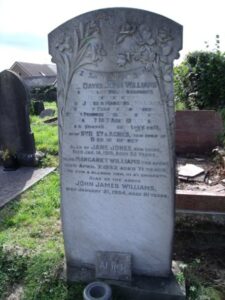
John Williams, Private, 1300, Welsh Guards. John was the son of David and Mary Williams, of Mount Pleasant, Pontyberem. He enlisted in Kingston, Surrey into the 1st Battalion, Welsh Guards, which had moved to France in August 1915, attached to 3 Brigade, Guards Division. The Division had a distinguished career during the Great War, fighting at the Battle of Loos, and through the Somme Offensive at the Battles of Flers-Courcelette and Morval. In 1917 they followed the German retreat to the Hindenburg Line, and then fought later that year at Third Ypres, at the Battles of Pilckem, the Menin Road, Poelcapelle and Passchendaele, and saw the year out fighting at the Battle of Cambrai. In 1918 they were near Gouzeaucourt when the area was hit by the German Spring Offensive of 21 March 1918. The Guards, as indeed were all of the British Divisions in the area, were pushed back beyond Bapaume towards Albert, where the German Offensive stagnated. The war turned during the month of August 1918 after a brilliant breakthrough at Villers Brettoneux on 8 August 1918 was followed by a successful British breakthrough on the old Somme Battlefields on 21 August 1918, when the Battle of Albert saw the Germans pushed back beyond Bapaume in a few terrible days fighting. John was killed in action here on 24 August 1918. He was 32 years old, and is buried at Mory Abbey Military Cemetery, Mory, France.
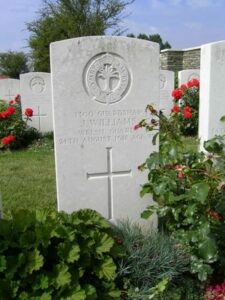
World War Two, 1939-1945
Arthur Pendragon Bowen, Captain, 125066, Pioneer Corps. Arthur was the son of David and Margaret Bowen, of Pentre Bach, Pontyberem. He had served during the Great War with the Welsh Field Company, Royal Engineers, seeing action in Gallipoli, Egypt and Palestine and was commissioned as an officer on 27 April 1918. He married Edith Helena Stephenson, of New Barnet, Hertfordshire in 1921. He had served with the Pioneer Corps, but died on active service on 14 February 1942, aged 54. Arthur is buried at Pontyberem (St. John) Old Churchyard. Arthur is not commemorated at Pontyberem.
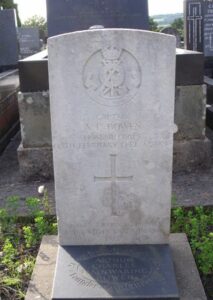
Thomas Donwy Crompton, Sergeant/Pilot, 524980, Royal Air Force. Thomas was the son of Oliver and Sarah Morgan-Crompton of Pontyberem and the husband of Eileen Margaret Crompton, of Derby. Thomas served as a Pilot with the RAF in the Far East, and was stationed at Java, at RAF Indonesia. On 28 February 1942 the Island of Java was attacked by two Japanese forces, which had split to launch a simultaneous attack from both the east and west sides of the Island. The Senior Allied Officers surrendered Java to the Japanese on 12 March 1942. Thomas had been killed during the Battle of Java, on 6 March 1942. He was 25 years old, and is buried at Jakarta War Cemetery. The photograph below has been kindly supplied by Tony Beck.
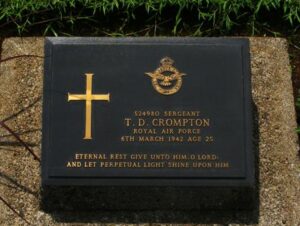
David John Davies, Private, WX8855, Australian Infantry. David was born on 10 November 1906, the son of Benjamin and Mary Davies, of Pontyberem. David had emigrated to Australia in 1928 and eventually found work as a labourer at Coolgardie. He enlisted at Claremont, Western Australia, into the 2/4th Machine Gun Battalion, Australian Infantry on 23 October 1940. David was among some 90 men locked up by the Military Police at Fremantle in January 1941, so was unable to board the SS Aquitania which sailed for Singapore on 16 January, leaving his battalion with a large hole to fill as most of the party were well trained machine-gunners. The battalion was captured by the Japanese when Singapore fell the following year. Upon his release, David was sent to Java in 1942 with ‘A’ Force Burma, Java Party No. 4, Williams Force, which joined ‘Blackforce’, an infantry unit named after its commander, Brigadier Arthur Blackburn VC. Blackforce gave a very good account of itself under appalling circumstances, before being left isolated when its flanking Dutch units gave way and Blackforce surrendered to the Japanese on 12 March 1942. David was initially shipped to Thailand with most of his comrades, and put to work on the Thai-Burma Railway, which meant that he worked from several camps as the railway was advanced into Burma. David fell ill whilst at Tamarkan Camp in July 1944 and died of Cerebral Malaria on 10 July 1944, aged 37. He was originally buried in Tamarkan War Cemetery, but after the war his grave was exhumed and re-located into Kanchanaburi War Cemetery. David is remembered on the Coolgardie War Memorial in Western Australia. For more details on David’s war, please see here: https://2nd4thmgb.com.au/soldier/wx8855/
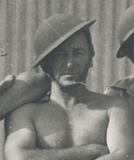
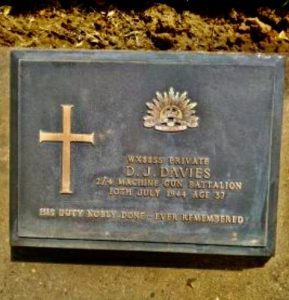
Idris Davies, Corporal, 3976296, Welch Regiment. Idris was the son of David Beynon Davies and Jane Davies of Llanwrcwrt, Pontyberem, and the husband of Rachel Sarah Davies, of Cotton End, Bedfordshire. Idris served in the 4th Battalion, Welch Regiment, which was the local Territorial Battalion, which was attached to the 53rd (Welsh) Division. The Division landed at Arromanches at the end of June, 1944 and fought through the Battle of Normandy, up through northern France into Belgium, and through Holland in 1944. Idris was killed in action during the Battle of s’Hertegonbosch on 24 October 1944. He was 32 years old, and was buried the following day at Uden War Cemetery. Idris is not commemorated at Pontyberem.
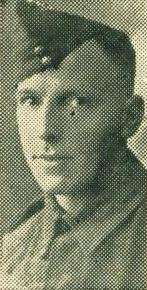
Lyndon Morgan Evans, Leading Aircraftman, 1303024, Royal Air Force Volunteer Reserve. Lyndon was born on 10 August 1920, the son of John Evans and Alice Sarah Evans (nee John), of Shore House, Pendine. He was living at Morawel, Pontyberem when war broke out, and worked there as a bus conductor. Lyndon enlisted into the Royal Air Force Volunteer Reserve soon afterwards and was posted to Whitehaven, for training. Whilst there he met, then married, Janet Tyson, a shoe shop assistant, in the spring of 1942. Lyndon was posted to RAF Dumbarton, in Dunbarton, Scotland at some time after this. The base was a Blackburn shadow aircraft factory and also served as a flying boat launching site during the war. Lyndon took ill during October 1944 and was taken to the Base Hospital at Larbert, where he died of diptheria on the morning of 15 October 1944. The body of the 24-year-old was brought to his wifes native Whitehaven, and he was buried in Whitehaven Cemetery, Cumbria. Lyndon is also commemorated on the Pendine War Memorial.

David Leslie Griffiths, Gunner, 1790054, Royal Artillery. David was the son of Mr. and Mrs. Idris Griffiths, of Pontyberem. He served with the 103rd Heavy Anti Aircraft Regiment, Royal Artillery, which was landed on Normandy on D-Day, 6 June 1944 as part of the main invasion force. David was killed in action in Normandy on 13 June 1944. He was 33 years old, and is remembered on the Bayeux Memorial.
Brynley Jones, Private, 97003127, Non Combatant Corps. Brynley was the son of Mr. and Mrs. T. Jones, of Pontyberem. He was called up into the Army, but was a Conscientious Objector, and so was posted to the Non Combatant Corps, which allowed people the right not to fight, but they had to serve the country by some other means. The men worked in clothing and food stores, transport, medical services, even Bomb Disposal, in fact anything not directly related to ‘material of an aggressive nature’. Brynley died at home on 11 February 1941, and is buried in Pontyberem (Caesalem) Congregational Chapelyard.
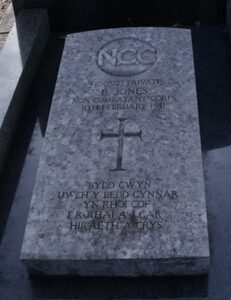
Reginald Saunders Lewis, Ordinary Seaman, LT/JX. 214956, Royal Naval Patrol Service. Reginald was the son of George J. Lewis and Janet Lewis, and served in the Royal Naval Patrol Service. The R.N.P.S. were known as ‘Churchill’s Pirates’, and served aboard requisitioned trawlers and fishing boats of all kinds, carrying out duties ranging from minesweeping to spying. Reginald served on H.M.S. Elan II, which was a Diverse Class Rescue Tug which had been commissioned into Admiralty Service on July 3rd 1940. Reginald died on duty on 22 March 1941. He was just 22 years old, and is buried at Pwll (Holy Trinity) Churchyard.
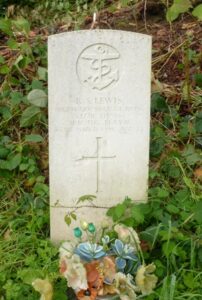
David Daniel Roblin, (W.Op/Air Gunner), 1022509, Royal Air Force Volunteer Reserve. David was the son of William John Roblin, and Alice Roblin, of Llanelly. Very little is known of him at present, but he served as a Wireless Operator/ Air Gunner in the Royal Air Force Volunteer Reserve, and died on 24 February 1944, aged 25. He is buried at Pontyberem (Caesalem) Congregational Chapelyard.
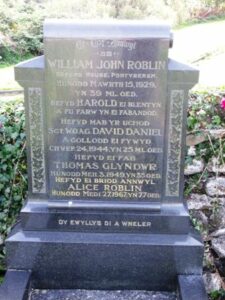
Owen Urijah Thomas, Flight Sergeant (Air Gunner), 919279, Royal Air Force Volunteer Reserve. Owen was born in the Narberth district late in 1919, the son of Vincent Thomas and Mary Ann Thomas (nee Evans). The family later moved to Mynachlog Farm, Pontyberem, and Owen was educated at Gwendraeth Grammar School between 1932 and 1940. Upon leaving school he enlisted into the Royal Air Force Volunteer Reserve and by 1944 had become posted to 76 Squadron, RAF, which was a Handley Page Halifax equipped Bomber Squadron, which had been formed at RAF Linton-on-Ouse on 1 May 1941. The Squadron flew night raids on strategic targets over France and Germany throughout the war, and on the night of 12 August 1944 Owen took off in his Halifax as part of a large bomber group bound for Brunswick, as part of an experiment to operate without a Pathfinder force. The aeroplane was intercepted and shot down on the journey, not far from the target, and Owen was killed in the resulting crash on 12 August 1944. He is buried at Rheinberg War Cemetery, Germany.
Wilfred Havard Vaughan, Air Mechanic 2nd Class FAA/FX. 75670, Royal Navy. Wilfred was the son of John and Annie Vaughan of Pontyberem. He served as an Air Mechanic in the Fleet Air Arm, aboard the Aircraft Carrier H.M.S. Glorious. Originally built during World War One as a Light Cruiser, H.M.S. Glorious was converted to an Aircraft Carrier in the 1920’s. When war broke out in 1939, Glorious was sent to the Mediterranean, and in April,1940 she was recalled to the Home Fleet, along with H.M.S. Ark Royal. She took part in the evacuation of Norway in June, 1940, and was returning to Scapa Flow when she was intercepted by the German Battlecruiser’s Scharnhorst and Gneisenau. Glorious and her two escorting destroyers were vastly outclassed by the German ships, and were sunk in minutes. Wilfred was lost with the ship that day, on 8 June 1940. He was only 20 years old, and is remembered on the Lee-On-Solent Memorial.
John Gareth Vaughan Williams, Sergeant, 1316732, Royal Air Force Volunteer Reserve. Gareth was born on 18 August 1921, the son of John Williams and Annie M. Williams, of Rehoboth Manse, Five Roads. He was educated at Llanelli County School prior to gaining a post with the Civil Service in Cheltenham and by the time war erupted was lodging at 12, Great Western terrace, Cheltenham. He enlisted into the Royal Air Force Volunteer Reserve and after completing his training as a Navigator was posted to 106 Squadron, Royal Air Force, a Bomber Command unit, which was equipped with the Avro Lancaster. On the night of 25 June 1943, Gareth took off from RAF Syerston aboard an Avro Lancaster I, Serial R5572, which joined a 473 bomber raid on Gelsenkirchen. During the early hours of the following morning, 26 June 1943, his Lancaster was intercepted by a German night fighter and shot down, crashing at Baak, near Zutphen, Holland, with the loss of all sex of her crew. The remains of Gareth, who was 21 years old, were recovered from the wreckage and buried together with his fellow crewmen in Steenderen General Cemetery, Gelderland, Netherlands.
